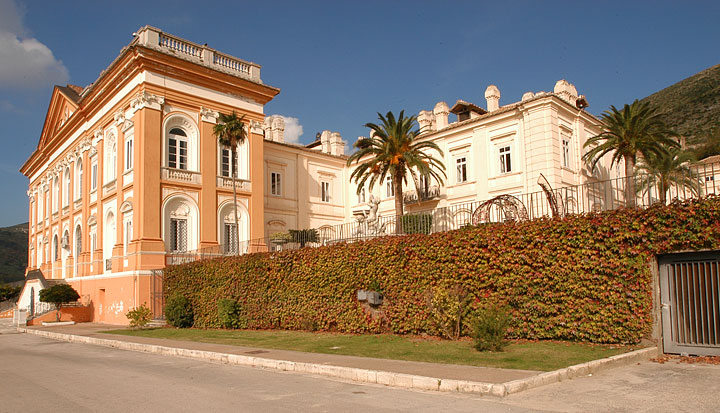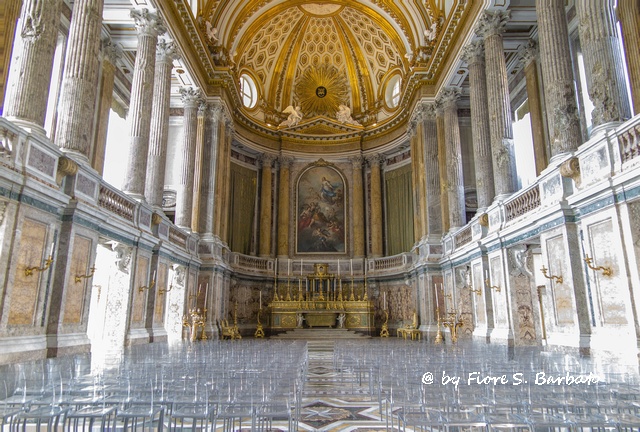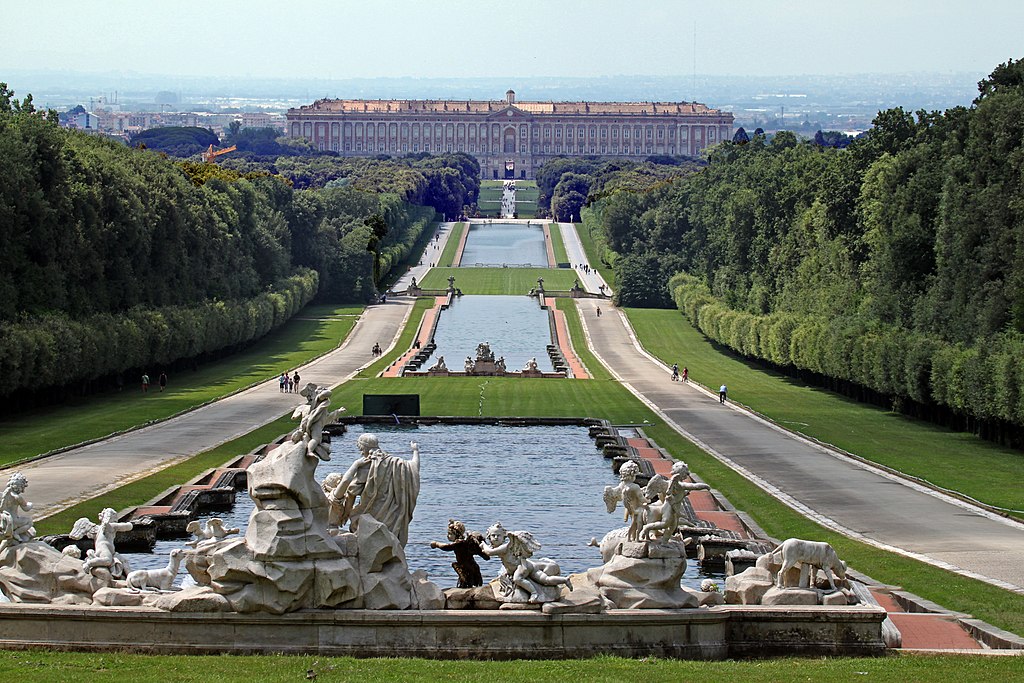Two Unesco sites in Caserta
The Royal Palace and its Park, the Vanvitelli Aqueduct and San Leucio Belvedere represant the monumetal complex of Caserta, masterwork of the brillant architecht Luigi Vanvitelli. In 1750 the King Charles of Bourbon entrusted him the project to build the House of the new capital of the Naples Kingdom.
In 1997, these monuments have been included in the List of World Heritage of Humanity by UNESCO, because they have been considered an eloquent material expression of the Age of Enlightenment, perfectly integrated into the natural environment.
Reggia di Caserta: beauty and strategy
Reggia di Caserta was built during the second half of the 18th century. Charles III of Bourbon wanted it strongly to make his wish: giving to the Kingdom of Two Sicilies, a beautiful and magnificent Royal Palace as well as the Palaces of Versailles and Madrid.
But the reasons that moved to build a new royal palace were strategic: Naples and its cost weren't safe, because the sea was a link to attacks by enemies; then, Naples was closer to the Vesuvius that would erupt at any moment. Also, there was a political reason: the king needed to guard the hinterland in the front line, where the barons, powerful and rich noblemen, used to have their houses.
So Charles of Bourbon, after transforming Naples into the most important cultural centre of the Reign and restored the old 16th-century Royal Palace, decide to "make" new administrative capital of land finally stolen to its viceregal condition. Indeed, the Palace in Caserta was the executive office of the New State, and not only the "king's house".
This so prestijous project was assigned to the architect Luigi Vanvitelli. At that time, he was committed to the Loreto Basilica's makeover on behalf of the Papal State.
Vanvitelli is the eldest son of the greatest landscape painter of that time, Gaspar Van Wittel. He studied in the Accademia San Luca in Rome, where he rediscovered the old architectural model and developed highly scenic abilities.
His studies and abilities highly express themselves in Reggia's architecture, starting a new architectural movement, the Vanvitelli's design, in other words, the recovering of the old design. He is the first to project a real interior design.
For Reggia's work, Vanvitelli asked the help of a group of young and skilled craftsmen from the Accademia of Naples. They then will be sand to further study in the Roman academy, where Vanvitelli used to study. They worked on the frescos and décor of the royal suite: a complex apartment that taking all the piano nobile of the Reggia di Caserta.
The Reggia doesn't develop horizontally but vertically: the most scenographic parts are probably the hall with the monumental staircase and the chapel. The staircase is an invention of 18th-century scenographic architecture: it links the lower and upper hallway, from where you access the royal suite. The Cappella Palatina, entirely designed by Vanvitelli, is certainly the environment, then more than any other, shows a clear analogy with Versailles' design. Through the staircase, you can also access the Court Theatre, a wonderful architectural example of 18th-century theatre: the horseshoe shape of the inside has an environment of exceptional architectural beauty.
The Reggia's Garden: art and nature
Vanvitelli's project for the Reggia required equal importance for the inside as well as the back garden. His gardens perfectly enter the landscape, but he also recovered an old garden, that owned by Prince Andrea Matteo Acquaviva, earlier vassal in Caserta.
An impressive waterway wholly acrosses the Gardens and connects the Palace to the city. It is fed by the Bosco San Silvestro's waterfall.
The Reggia's Park is an unparalleled view! During the three kilometres of the central large avenue, you will meet its Myth's Fountains, which each tells a story:
- the Dolphins Fountain: with on the centre the Sea Moster;
- Aeolus's Fountain: the God of Winds against Aenea and the Trojans;
- Cerere's Fountain: a tribute to the Sicily admitted to the Kingdom;
- Venus and Adonis' Fountain: who celebrates the love story that ends tragically;
- Diana and Actaeon's Fountain: the myth of the hunter transformed into a deer and then fed to Diana's dogs because he had violated the Goddess privacy.
Caroline Aqueduct and Bosco San Silvestro
The Caroline Aqueduct was used to bring the water to the waterfalls and fountains of Reggia. It is an engineering masterpiece inspired by the Roman aqueducts and better too. It represents one of the most important public work made by Bourbons.
Luigi Vanvitelli excavated big wells, raised to 60 meters a long 528 meters viaduct called Valley's Bridges, a bridge with three arches made to reach the high valley of Maddaloni. The Aqueduct covers 38 km and its water fed the Reggia's waterfall and San Leucio factory.
The Aqueduct enters inside the San Silvestro Forest, a 100-hectare estate on the back of the Royal Park's waterfall. Charles of Bourbon bought it and made it fit for the haunting, cultivation of vineyards and olives, production of fine cheeses. Inside, on Mount Briano's hill, there is the San Silvestro Real Casino. The king used to stay here during his hunting trips. Since 1993, San Silvestro Forest is a 76-acres WWF Oasis.
Real Belvedere San Leucio

The Real Belvedere of San Leucio is on the top of a green hill. The King Ferdinand IV of Bourbon, after the death of his 3-year first and only son, decided to transform the hunting lodge, called Belvedere for its wonderful view, in a big factory of silk. He trained the citizens to become excellent artisans and so to let work them in.
The monumental complex of San Leucio includes, in addition to the Silk Museum, the royal apartments with their beautiful frescos of the dining room made by Fedele Fischetti, which recreate The Marriage between Bacchus and Ariadne, and Maria Carolina's bathroom with its walls decorated by Philipp Hackert.
Since the 18th century, most parts of the fabrics made in San Leucio were for the decor: they used to make fabric for bedcovers, curtains, hangings. Firstly, the frames were enough small, the produced fabric measured around 60-80 cm, then bigger frames arrived and they could produce also queen-sized blankets longer than 2 meters.
One of the biggest Borbonic silk production items was the silk blanket, made of 28 thousand strings. Every betrothed must have one before the marriage.
The Belvedere of San Leucio used to have a Special Statute that established that there wasn't any difference among the people, whatever work they did. Men and women had the same rights in a system founded on meritocracy.
San Leucio products can be admired in the main museums of the world. Many flags, such as the British in Buckingham Palace, the American of the Oval Office in the White House and the Italian in the government buildings Quirinale and Palazzo Chigi, are made in San Leucio.














Lascia un commento